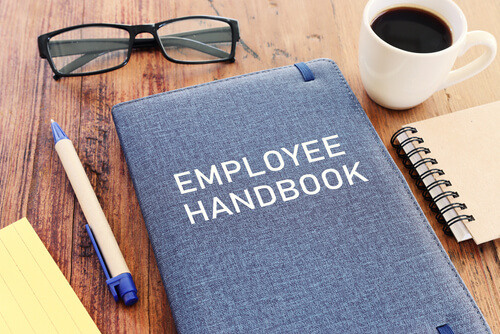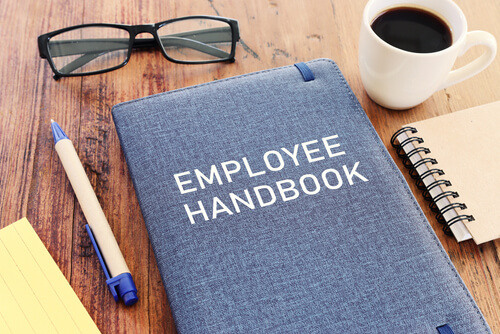
Growing a successful business relies as much on fostering a workplace where employees feel valued, understood, and engaged as selling great products or services. One of the best tools to achieve this is an effective employee handbook – since it helps forge a quality culture for your new and existing staff.

Handbooks help your staff get up to speed quickly, gives them a handy reference, and lays out your strategies for compliance to protect yourself in case of an issue. But what should be included in an employee handbook?
In this comprehensive, we explore the qualities of effective handbooks, what should be included in them, and how they can benefit your company as a long-term strategy.
Qualities of an Effective Handbook
Every great employee handbook shares several key qualities that ensure it’s both a resource and a protective tool for your business.

Well-written handbooks aid in compliance and consistency by clearly defining company policies and ensuring they are uniformly applied, helping to avoid confusion and ensure all employees are treated fairly. However, it should not handcuff your business. Handbooks must be flexible enough to evolve with changes in laws, company strategy, and industry standards.
Crucially, it must be tied back to company strategy, reflecting the organization's mission, vision, and values. This alignment helps reinforce your company culture and strategic objectives. An effective handbook is a smart document that thinks many steps ahead. It anticipates potential issues and addresses them proactively, reducing the risk of misunderstandings and disputes.
Your handbook is also a living document that changes with your company. At a minimum, it should be updated as laws and strategies change to ensure ongoing compliance and relevance. Regular reviews and updates are key to maintaining its effectiveness.
Above all, the handbook should be followed as reasonably as possible. If policies are too rigid or unrealistic, they may be ignored, undermining the handbook’s purpose.
Key Details to Include in an Employee Handbook
Now, let's break down the essential components that make an employee handbook comprehensive and effective.

Company Mission and Values
Start by clearly outlining your company’s mission, vision, and core values. This aligns employees with the organizational culture and sets the tone for what is expected of them.
Employment Policies
Include detailed information on hiring practices, job classifications, probationary periods, and termination procedures. This helps employees understand the recruitment process and their employment terms.
Code of Conduct
Detail expectations regarding professional behavior, workplace etiquette, and interactions with colleagues and clients. A clear code of conduct helps maintain a respectful and productive work environment.
Compensation and Benefits
Provide comprehensive information on salary structure, bonuses, health insurance, retirement plans, and other employee benefits. This transparency helps employees understand and appreciate their compensation package while also knowing what’s available across the company.
Work Hours and Attendance
Set clear guidelines for work hours, breaks, attendance, punctuality, and procedures for requesting time off. This ensures consistency and fairness in managing work schedules and also lays out common procedures, which can be useful if your company runs into any inquires regarding wage and hour law.
However, it is recommended to leave some room for flexibility so employees can manage their work-life balance, like if they need to leave early on certain days for a family obligation.
Leave Policies
Explain the various types of leave available, including vacation, sick leave, family and medical leave, and any other relevant leave policies. Clear leave policies help employees plan their time off and ensure they understand their entitlements.
Health and Safety
Outline procedures and policies to ensure a safe and healthy work environment, including emergency protocols and workplace ergonomics. A focus on health and safety shows employees that their well-being is a priority. If your workplace is in a high-risk setting (like manufacturing or restaurants), laying out safety and protective plans can reduce the risk of injury and decrease liability if an accident does occur.
Disciplinary Procedures
Describe the process for addressing policy violations, including disciplinary actions and grievance procedures. This ensures that disciplinary actions are fair and consistent.
Performance Evaluations
Include guidelines for performance reviews, feedback processes, and career development opportunities. Clear performance evaluation processes help employees understand how their performance is measured and how they can grow within the company.
Privacy and Confidentiality
Address policies regarding the protection of company and employee information, data security, and confidentiality agreements. This helps protect sensitive information and builds trust.
Technology and Social Media Use
Define appropriate use of company technology, including internet, email, and social media guidelines. Clear policies on technology use help prevent misuse and protect the company’s digital assets. This can also include online safety, like guidelines for verifying email senders to decrease the risk of phishing scams or other malfeasance.
Anti-Discrimination and Harassment Policies
Emphasize the company’s commitment to a diverse, inclusive, and respectful workplace, detailing policies against discrimination, harassment, and bullying. These policies are crucial for creating a safe and welcoming work environment.
How an Employee Handbook Helps Your Company
A comprehensive employee handbook offers numerous benefits to your organization, enhancing both operational efficiency and employee satisfaction.

Consistency in Policy Enforcement
A well-drafted handbook ensures that all employees are aware of the company policies, leading to consistent enforcement across the organization. Consistency helps maintain fairness and reduces the risk of legal issues because you have a detailed and public record of your policies, which can be evidence for your policy enforcement.
Clear Communication
By providing a clear and accessible resource for employees to understand their rights, responsibilities, and benefits, a handbook improves communication and reduces misunderstandings. It also provides a guide for management to navigate any situation.
Legal Protection
An employee handbook helps protect the company from potential legal issues by clearly defining policies and procedures that comply with labor laws. They can establish procedures that help your company adhere to compliance regulations – but they can also be invaluable in defending against wrongful termination, discrimination claims, or wage and hour inquiries.
Onboarding Efficiency
A detailed handbook streamlines the onboarding process by providing new hires with essential information about the company and its expectations. This helps new employees integrate quickly and effectively.
Improved Employee Relations
By clearly outlining policies related to workplace conduct, anti-discrimination, and harassment, a handbook fosters a positive workplace environment. This helps improve employee relations and reduce conflicts.
Conflict Resolution
A handbook offers a reference point for resolving disputes and misunderstandings, reducing the likelihood of conflicts escalating. Clear policies and procedures help managers resolve conflicts effectively and fairly.
Performance Management
Effective performance management is supported by a handbook that clearly outlines evaluation processes and career development paths. This helps employees understand how to succeed and grow within the company.
Enhanced Morale and Trust
A transparent handbook builds trust between employees and management by demonstrating a commitment to fair practices. This can enhance morale and loyalty among employees.
Operational Efficiency
By standardizing procedures and reducing confusion over company policies, a handbook improves overall operational efficiency. This helps the organization run smoothly and effectively.
Health and Safety Assurance
Promoting a safe and healthy work environment is easier with a handbook that clearly outlines health and safety protocols and emergency procedures. This helps ensure compliance with safety regulations and protects employees.
Get HR Insight with Outsourced HR
Creating and maintaining an effective employee handbook can be challenging, especially for growing businesses. This is where outsourcing HR to a trusted HR partner like PRemployer can be invaluable. PRemployer offers professional guidance, expertise, and assistance in developing and updating your employee handbook, ensuring it meets legal requirements and aligns with your company’s strategy. By leveraging PRemployer's expertise, you can focus on growing your business while ensuring your employees have a comprehensive and effective handbook to guide them.
An effective employee handbook is an indispensable tool for growing businesses. It helps ensure compliance, fosters a positive workplace culture, and protects the organization from potential legal issues. By including essential details such as company mission and values, employment policies, code of conduct, and more, you can create a comprehensive resource that benefits both employees and the organization.
Ready to create a comprehensive employee handbook for your business? Contact us today to learn more about how we can help you achieve your HR goals.

